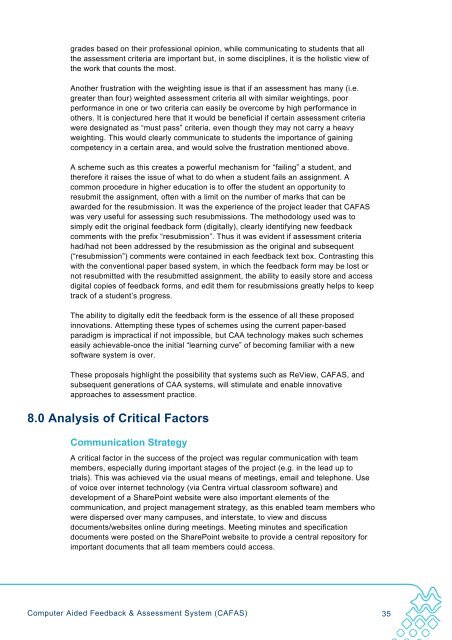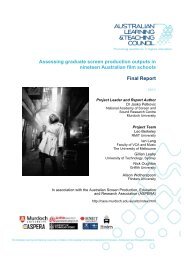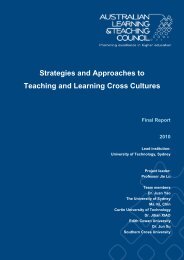Although <strong>Freney</strong> and Williams’ 21 study was limited to design studios, similar situationsin which the venue <strong>for</strong> assessment is not the academic’s desk, such as practicals, mayalso find this approach to be beneficial.A similar ALTC project also utilised a new online criteria-based assessment systemcalled ReView. The main focus of ReView is on linking graduate attributes toassessment criteria, and it has the facility <strong>for</strong> self assessment whereby students ratetheir per<strong>for</strong>mance on a sliding scale prior to their assessment. Of note is the fact thattutors (the assessors) are not able to view the students’ self assessment until theyhave made their own assessment, thereby overcoming any prejudice that the selfassessment might induce 22 . Class averages <strong>for</strong> each assessment criterion are alsodisplayed, a feature shared with CAFAS.An interesting possibility <strong>for</strong> an innovative assessment practice, based on the digitalstorage of feedback <strong>for</strong>ms provided by CAFAS is proposed here <strong>for</strong> futureexperimentation. If the same assessment criteria were utilised across all assessmenttasks in a course/unit/subject (they must be the same but could be weighteddifferently), it would be possible to map the development of a student’s progress in aparticular criterion in terms of a summative mark and <strong>for</strong>mative comments across aseries of assessment tasks (i.e. the whole course/unit/subject). Thus, rather thancreating a new feedback <strong>for</strong>m <strong>for</strong> subsequent assessment tasks, the original feedback<strong>for</strong>m could be appended, thereby clearly displaying the history of comments and marksthat a student received in that course. At the culmination of the course, the feedback<strong>for</strong>m having been appended <strong>for</strong> each assessment task, would show the evolution of thestudent’s learning and highlight whether they were responding to feedback andimproving in each assessment criterion.There is potential <strong>for</strong> the Rubric functionality to easily become a “checklist” in whichrather than a limited list of per<strong>for</strong>mance levels – typically there are four to seven levelswhich roughly correspond to the grade levels – there would be an extensive list ofattributes each carrying a certain number of marks. The academic would “tick” eachapplicable attribute to communicate what had and had not been addressed in thestudent’s assignment submission. Marks would be tallied automatically giving anoverall score <strong>for</strong> a particular assessment criterion. This checklist <strong>for</strong>mat could becomeanother option <strong>for</strong> assessing a particular assessment criterion, thus three options couldbe possible: Slider, Rubric or Checklist.The issue of the validity of weighted assessment criteria arose during presentations ofthe system. Colleagues from various disciplines argued that weightings limited theircapacity to allocate the final grade that they wanted to award. A rigorous system suchas CAFAS, which relies on weighted assessment criteria to calculate an overall gradeand mark <strong>for</strong> the assignment sometimes tends to override one’s intuition regarding thegrade a student should be awarded. However, it was suggested to these colleaguesthat they could overcome this problem by specifying very small weightings <strong>for</strong> themajority of assessment criteria, reserving the largest weighting, <strong>for</strong> example, 80-90%<strong>for</strong> an “overall per<strong>for</strong>mance” criterion. This would give them the freedom to award21 <strong>Freney</strong>, M & Williams, T. 2007.22 Thompson, D.G. 2008, “Software as a facilitator of graduate attribute integration andstudent self-assessment”, ATN Assessment Conference 2008: Engaging Students inAssessment., University of South Australia, November 2008 in ATN AssessmentConference 2008: Engaging Students in Assessment., ed Duff, A., Quinn,D., Green, M.Andre, K., Ferris, T., Copeland, S., Australian Technology Network, South Australia, pp.234-246.Computer Aided Feedback & Assessment System (CAFAS) 34
grades based on their professional opinion, while communicating to students that allthe assessment criteria are important but, in some disciplines, it is the holistic view ofthe work that counts the most.Another frustration with the weighting issue is that if an assessment has many (i.e.greater than four) weighted assessment criteria all with similar weightings, poorper<strong>for</strong>mance in one or two criteria can easily be overcome by high per<strong>for</strong>mance inothers. It is conjectured here that it would be beneficial if certain assessment criteriawere designated as “must pass” criteria, even though they may not carry a heavyweighting. This would clearly communicate to students the importance of gainingcompetency in a certain area, and would solve the frustration mentioned above.A scheme such as this creates a powerful mechanism <strong>for</strong> “failing” a student, andthere<strong>for</strong>e it raises the issue of what to do when a student fails an assignment. Acommon procedure in higher education is to offer the student an opportunity toresubmit the assignment, often with a limit on the number of marks that can beawarded <strong>for</strong> the resubmission. It was the experience of the project leader that CAFASwas very useful <strong>for</strong> assessing such resubmissions. The methodology used was tosimply edit the original feedback <strong>for</strong>m (digitally), clearly identifying new feedbackcomments with the prefix “resubmission”. Thus it was evident if assessment criteriahad/had not been addressed by the resubmission as the original and subsequent(“resubmission”) comments were contained in each feedback text box. Contrasting thiswith the conventional paper based system, in which the feedback <strong>for</strong>m may be lost ornot resubmitted with the resubmitted assignment, the ability to easily store and accessdigital copies of feedback <strong>for</strong>ms, and edit them <strong>for</strong> resubmissions greatly helps to keeptrack of a student’s progress.The ability to digitally edit the feedback <strong>for</strong>m is the essence of all these proposedinnovations. Attempting these types of schemes using the current paper-basedparadigm is impractical if not impossible, but CAA technology makes such schemeseasily achievable-once the initial “learning curve” of becoming familiar with a newsoftware system is over.These proposals highlight the possibility that systems such as ReView, CAFAS, andsubsequent generations of CAA systems, will stimulate and enable innovativeapproaches to assessment practice.8.0 Analysis of Critical FactorsCommunication StrategyA critical factor in the success of the project was regular communication with teammembers, especially during important stages of the project (e.g. in the lead up totrials). This was achieved via the usual means of meetings, email and telephone. Useof voice over internet technology (via Centra virtual classroom software) anddevelopment of a SharePoint website were also important elements of thecommunication, and project management strategy, as this enabled team members whowere dispersed over many campuses, and interstate, to view and discussdocuments/websites online during meetings. Meeting minutes and specificationdocuments were posted on the SharePoint website to provide a central repository <strong>for</strong>important documents that all team members could access.Computer Aided Feedback & Assessment System (CAFAS) 35
















